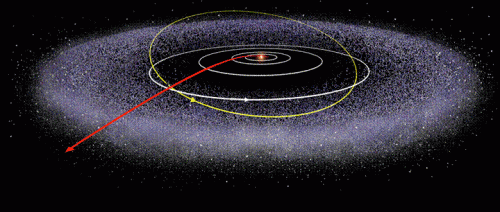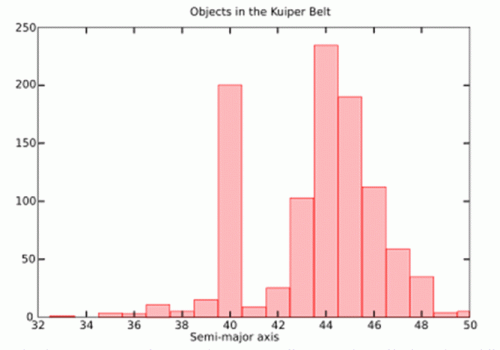The Kuiper Belt at 20

Planetary science is celebrating the 20th anniversary of the discovery of the Kuiper Belt. That came in 1992, when the first Kuiper Belt Object (KBO) was discovered.
Actually, of course, the first object in the Kuiper Belt was discovered in 1930—Pluto itself; and the second such object, Pluto's giant moon Charon, was discovered in 1978. The Kuiper Belt was first postulated—most famously by Gerard Kuiper—by planetary scientists back in the 1930s, '40s and '50s. But it took until 1992 for technology to mature sufficiently enough to find another object (outside the Pluto system) orbiting the Sun beyond Neptune.
Since 1992, more than 1,000 KBOs have been discovered. But only a tiny fraction of the sky has been surveyed for KBOs. It is estimated that more than 100,000 KBOs exist with diameters of 100 kilometers or larger, along with billions of smaller objects down to the size of cometary nuclei, just a kilometer or two across. (By comparison, Pluto is huge—its diameter is almost 2,400 kilometers, making a drive around its equator as far as from Manhattan to Moscow!)
Most of the known KBOs are just 100 to 300 kilometers across, about one-tenth of Pluto's diameter. But some are smaller than 100 kilometers across, and some are larger than 300 kilometers across. In fact, there is great diversity among KBOs:
- Some are red and some are gray;
- The surfaces of some are covered in water ice, but others (like Pluto) have exotic volatile ices like methane and nitrogen;
- Many have moons, though none with more known moons than Pluto;
- Some are highly reflective (like Pluto), others have much darker surfaces;
- Some have much lower densities than Pluto, meaning they are primarily made of ice. Pluto's density is so high that we know its interior is about 70% rock in its interior; a few known KBOs are more dense than Pluto, and even rockier!

- That our planetary system is much larger than we used to think. In fact, we were largely unaware of the Kuiper Belt—the largest structure in our solar system—until it was discovered 20 years ago. It's akin to not having maps of the Earth that included the Pacific Ocean as recently as 1992!
- That the locations and orbital eccentricities and inclinations of the planets in our solar system (and other solar systems as well) can change with time. This even creates whole flocks of migration of planets in some cases. We have firm evidence that many KBOs (including some large ones like Pluto), were born much closer to the Sun, in the region where the giant planets now orbit.
- And, perhaps most surprisingly, that our solar system, and very likely very many others, was very good at making small planets, which dominate the planetary population! Today we know of more than a dozen dwarf planets in the Solar System, and those dwarfs already outnumber the number of gas giants and terrestrial planets combined. But it is estimated that the ultimate number of dwarf planets we will discover in the Kuiper Belt and beyond may well exceed 10,000. Who knew? (And which class of planet is the misfit now?)

Just imagine—when the New Horizons spacecraft has its close flybys of the Pluto system and smaller KBOs, combined with new giant telescopes coming on line to probe the sky—what we will learn about the Kuiper Belt in the next 20 years. It's an exciting time, and its sometimes hard for me to believe after working on this since 1989, that our 2015 exploration of Pluto and its many moons is almost upon us—but it is!
New information about the Solar System is important to astrobiologists who are trying to determine how our system evolved to support the only habitable planet yet known - Earth. This knowledge is useful in determining where else in the Universe habitable planets might exist.
Source: Astrobio.net



















